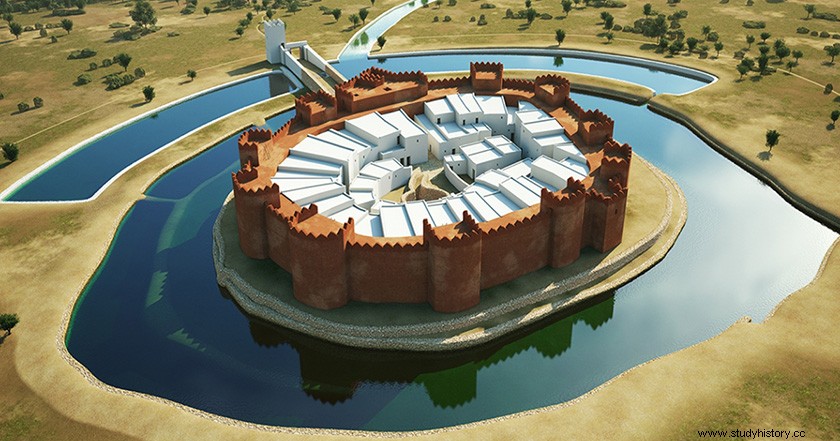
The recreation using 21st century techniques of the town of Vilars d'Arberca It transports us to an Iberian world, without a doubt, more technologically advanced than we can sometimes imagine. To get to know it a little better, we must go to the Catalan region of Las Garrigas, known, among other reasons, for the production of excellent Arbequina olive oil. There we will discover one of the most impressive and, above all, enigmatic archaeological sites in the entire protohistory of the Iberian Peninsula.
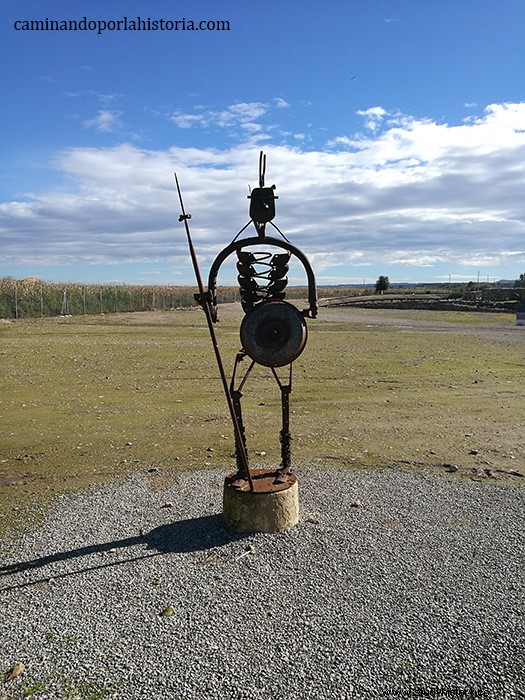
Welcome to Vilars d'Arberca
Around 775 BC. C. in the final stage of the prehistoric culture of the urn fields, the construction of this impressive fortress begins. Later, its inhabitants, protected by the arrival of the Phoenicians and Greeks, soon began, like the rest of the peoples settled in the vicinity of the Mediterranean Sea, a process known as Iberianization, to become the people of the Ilergetes. The phase of greatest splendor of the town must have been around the 6th-5th centuries BC. C., although the wall built from the beginning, always constituted a border that did not allow it to grow. For some reason that continues to generate great doubts among experts, the town was totally abandoned in the year 300 BC. C.
That is to say, the adjective "enigmatic" placed previously, is more than justified in the site of the town of Vilars d'Arbeca . Apart from the exposed dates, everything else generates enormous doubts:Why the enormous walls? What reason led its founders to choose that place? Or why there is no destruction or traces of violence in its abandonment? All these, and some more, are the doubts that the fortress has generated during its more than 40 years of study. Specifically since one day in 1974, when Emili Junyet, Professor at the University of Lérida, at that time working on his doctoral thesis, reached the hands of some wall remains found in the vicinity of the town of Arbeca. Although we still had to wait another decade, the excavations yielded surprise after surprise.
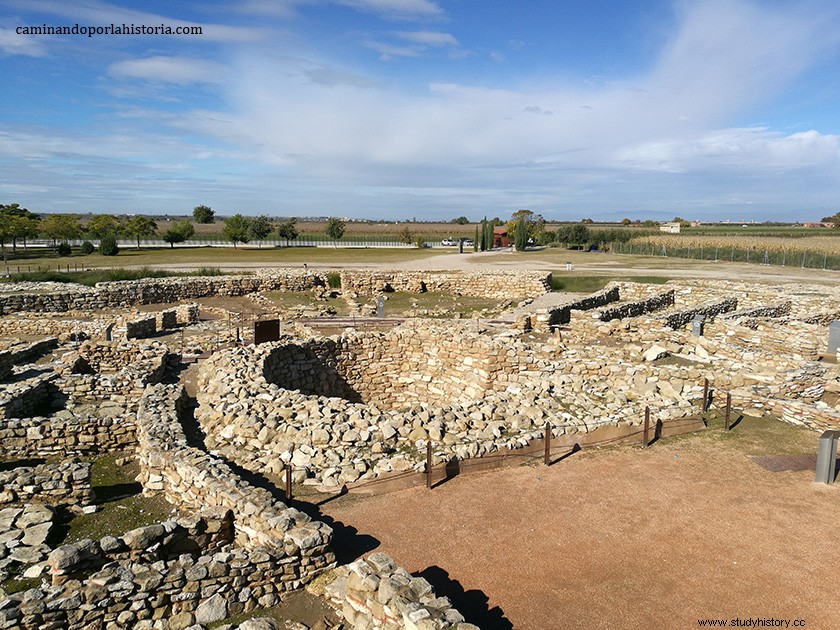
Cistern in the center of the town of Vilars d'Arbeca
An impenetrable defensive system.
It is evident that this point is the one that can most surprise, at first glance, the visitor who arrives today at Vilars d’Arberca . The town was erected in an unusual area with respect to the canons of construction of the first millennium BC. C. If most of the towns of this time took advantage of small elevations of the terrain to favor their defense, Vilars It was built in the center of a large plain, at most, according to archeology, there was at that time a small undulation, produced by the sedimentation of runoff from a small torrent. Said torrent is the most logical explanation found by Vilars scholars. , for the establishment in said place.
The walls were the first element to be built in the city, since the inner houses appeared attached to it. A Frisian field was added to this walled space in the first place, that is, it was surrounded by stones nailed to the ground vertically, its usefulness delaying and hindering the march of possible assailants. This element will soon be replaced by the large water pond that surrounded the entire town, this was achieved after a great job of waterproofing the land, to take advantage of the existing groundwater in the area. We must emphasize that the raft was not perpetual, but could be flooded when necessary, this aspect gives this Iberian fortress exclusive characteristics, and reveals the great engineering skills of the Iberian Ilergetes.
The wall was adapted to changes in the terrain during the more than 400 years that the town lasted, up to four different construction levels have been verified:(Vilars I, II, III; IV) are the ones chosen by the experts for the explanation of the site. The result was a kind of concentric rings, where the first walls served on the one hand as foundations for the later ones, each time higher, and on the other as containment for the outer pool. It should be noted that the final wall had 12 towers, of which only the one at the main entrance seemed to have defensive characteristics, as there was an open space inside to make it unusable as a dwelling for the lookouts and access to the upper part, the rest seem be more structural. Add that the wall had three doors, only one of them with direct access to the entrance walkway, all three of small dimensions that favored the defense, as two people did not pass at the same time.

One of the three entrances to Vilars d'Arbeca
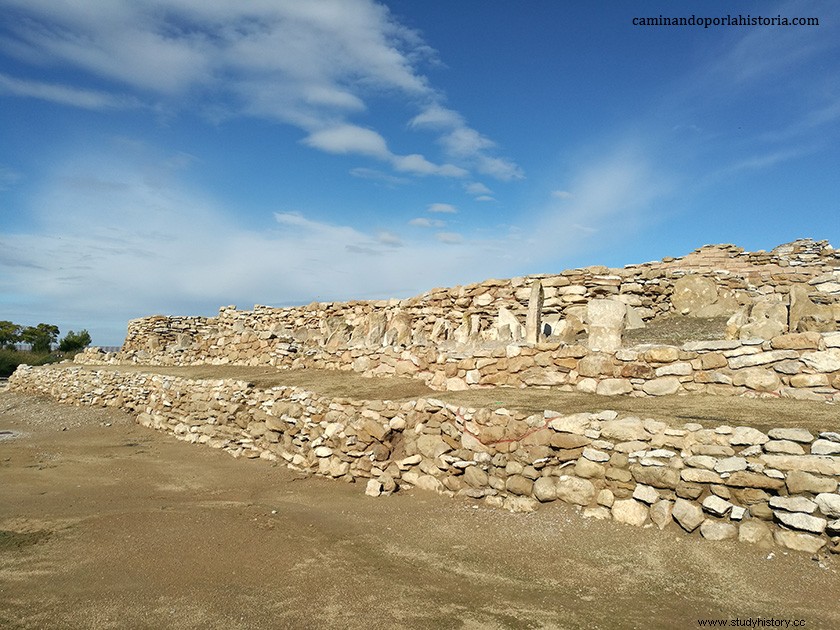
Remains of the wall where the Frisian countryside can be seen

The main entrance to Vilars d'Arbeca

The extramural floodable space
Economy of Vilars d’Arbeca .
The Lleida Plan , where Vilars d’Arbeca, is located it was 2,800 years ago and today one of the most fertile places in the western Mediterranean. The inhabitants of the town had these rich lands within their reach, for which they can be considered totally self-sufficient.
In the field of agriculture highlight the production of cereals, especially wheat and barley. A very interesting aspect of the site is the lack of the typical excavated silos for product storage. Experts interpret it as a sign of self-sufficiency and security in the fertility of the land, but without ruling out high-rise storage inside homes. They also ate legumes such as broad beans and lentils, although to a lesser extent than cereals.
The livestock It was also very prominent in Vilars d’Arbeca , like any Iberian town with goats and sheep as the most representative animals. It has been confirmed that those used for meat were slaughtered at an early age, while a smaller number became adult animals, to use their wool or leather, and their milk was used to make dairy products, including cheese. To a lesser extent, the remains of pigs also destined for consumption have been located, as well as the typical and necessary cattle or horses destined to help in agricultural tasks. As was customary, the animals lived together within the town with their families, but today some remains of structures found next to one of the gates of the wall are being studied, as possible stables.
Also highlight metallurgy practiced by the inhabitants of Vilars . Thanks to the remains of molds found in the houses, we know of the production of small bronze objects, the vast majority of them objects for personal use, such as brooches, bracelets, or pendants, etc. But more importance seems to be that it had the production of iron, since the remains of a blacksmith shop have been found, curiously next to one of the largest houses. This aspect is interpreted as the family that inherited this production, would hold the title of chiefs of the town. Another noteworthy aspect is the early dating of this smithy, since we can think that it was built in the early days of Vilars , just beginning the VIII century a. C., a fact that leads us to think that they were pioneers in this geographic space of the peninsular northeast. It should be noted that most of the products that emerged from the workshop were entrusted to agricultural tasks, without a doubt a contradictory point with the great walls that want to present us with a warrior leadership of great importance.
The trade at medium and long distance it was also present in Vilars d’Arberca, The Mediterranean Sea is about 80 km from this town, and its inhabitants must have learned the way well. The ports that the Greeks and Phoenicians must have had in this area were an exchange point for the agricultural surpluses of this Iberian settlement, since rich Greek ceramics, both red figures and black varnish, have been located in the site. Phoenician amphorae, possibly from Aldovesta, and Punic amphorae, in this case most likely from Ibiza, are also present. Two other products have drawn the attention of archaeology, the remains of marine animals destined for consumption. And above all the enormous amount of stone from the Mèdol Quarry . Exactly the place where the stone for the monumental Tarraco was extracted. roman , had been a regular place of work for the inhabitants of Vilars d’Arbeca , centuries before the arrival of the Mediterranean power.

More walled remains with the stone from the Médol quarry
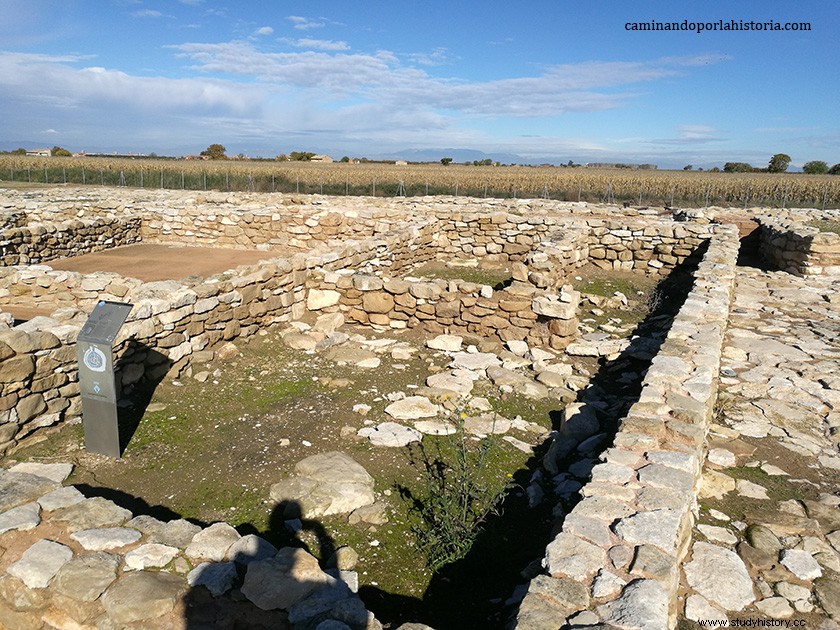
The blacksmith's house in Vilars d'Arbeca

From the highest part of the town of Vilars d'Arbeca, the view of the crop fields, and in the background the Pyrenees more than 100 km away
Society and religion in Vilars d’Arbeca.
One of the most remarkable facts of the inhabitants of Vilars , is their predisposition to share public spaces. The large cistern in the center of the fortress, built in the Iberian period, that is, by the Ilergetes, shows us the main meeting point for the inhabitants of the fortress, so the water was guaranteed and in the public domain. Next to it, the remains of eight ovens have been found, their use must have been the elaboration of food, since in the houses hardly any remains of small hearths have been found, destined to heat them and the house in the harsh winter of the Flat of Lleida .
Another aspect to consider is the dimensions of the homes . If when the first Vilars was built, these could have more than 50 m2, in the final occupation period they did not exceed 30 m2. The houses were destroyed and rebuilt to share the territory, where there were two single-family houses, three appeared after a few years. On the amount of population that the town had, various studies have been carried out. As is known, the Iberians were able to practice birth programs appropriate to the environment, but in Vilars d’Arbeca This aspect is not so clear. The population in the end could exceed 200 people, this is one of the reasons put forward by the experts to explain the abandonment of the town.
The Iberian religion is also present in this deposit. Since the remains of a public building have been located next to the main entrance of the north gate. Its total dimensions were more than 50 m2, and it is not ruled out, due to the structure of its foundations, that its height was even higher than that of the wall. It was distributed in three rooms; the main one where the ceremony would take place, including the sacrifices, an antechamber that could contain the offerings, and lastly, next to the entrance, a small room with a pile on the floor, which is speculated to have been used to store the small animals prepared for the sacrifice.
On the other hand, highlight that the burials from Vilars d’Arbeca they followed the typical pattern of the Iberian peoples, and more so here in the north, where we must have the heritage of the Urn Fields Culture. In Vilars Nearly thirty bodies of young children have been recovered under the continuous benches of the houses, a common occurrence in this culture. But the necropolis where the cremated remains of its inhabitants were placed is still not located, the surroundings of the site are currently privately owned agricultural land, which makes the search for archaeological remains more complicated.

The religious site of Vilars d'Arbeca

Remains of the eight public ovens

Vilars d'Arbeca even had sewers for extracting water from inside the town.

The floor plan of the elongated house of the Iberians in Vilars d'Arbeca
Conclusions.
I cannot conclude this article without showing a very personal opinion of it. After leaving Vilars It is difficult for me to call it a fortress, although it is true that it is the most spectacular aspect of it, the lack contrasted by archaeologists of remains of weapons and the null indications of destruction during its more than 400 years, can make anyone doubt a society warrior.
On the other hand, note that Vilars d’Arbeca It is the most impressive Iberian site in the Iberian Peninsula, not because of its size, but because we are facing a site only inhabited by pre-Iberians and Iberians, so it becomes a practically unique site to learn about the Iberianization process. Walking through those stones cannot leave anyone indifferent, undoubtedly changing the perception of our Iberian ancestors.
The guided tour of the site contributes to this last aspect. The same, and the municipal website of Arbeca are the two main sources for the preparation of this article. This point is also very remarkable, the exploitation of the deposit is carried out by the Arbeca city council, which holds its ownership, it is worth noting the great work they have done in recent years to value it. The residents of the municipality feel that Vilars d’Arbeca in some way it is a good for all and this is demonstrated by the way it is managed. As those responsible for the management of the visits tell you, despite the fact that these are only carried out on weekends, and on request from Monday to Friday, if someone arrives with a great interest, they do not mind accompanying them, as long as may be possible. During the two or three weeks a year that the archaeologists spend at the site, they are usually hosted by the residents of the municipality.
After all, all that remains is to recommend your visit, you can find the hours and different forms of contact on their website:www.vilars.cat
